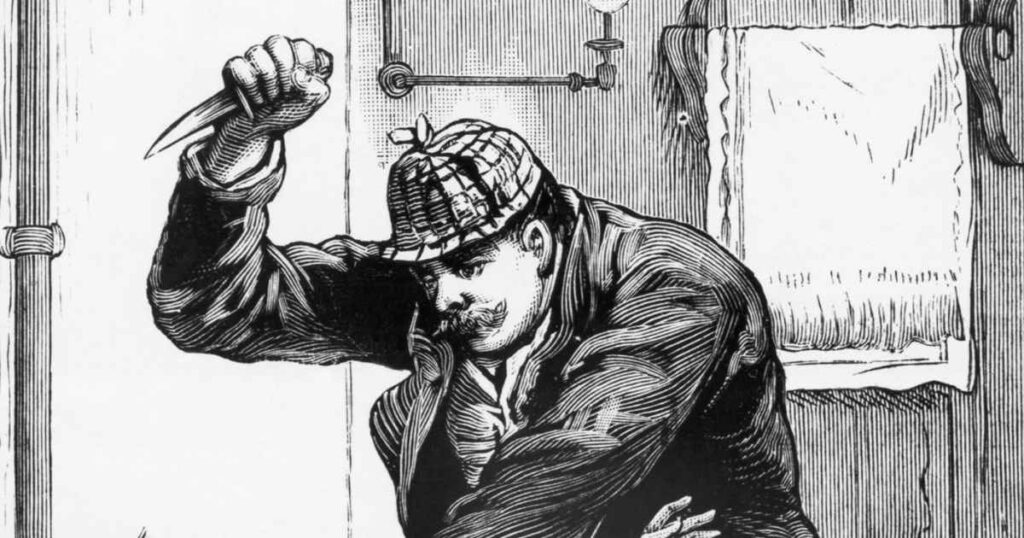
The notorious serial killer known as Jack the Ripper may finally have been identified more than 130 years after he terrorized Victorian era England.
The story of Jack the Ripper has transfixed generations of true crime aficionados and terrified viewers of classic film and TV depictions. Perhaps the most notorious unsolved serial killer case in history, there have been endless theories about who Jack the Ripper truly was, but no definitive evidence until recently. Researchers have conducted a DNA test that could prove conclusively the identity of the brutal killer. Descendants of Jack the Ripper’s victims and researchers are now calling on the U.K. government to hold a formal inquest into their DNA findings.
Keep scrolling for the full story on Jack the Ripper’s suspected murders, the latest breakthrough in his case and a rundown of some of the most iconic depictions of the killer.
The Killing Spree and Theories
Jack the Ripper was linked to the murders of Mary Ann Nichols, Annie Chapman, Elizabeth Stride, Catherine Eddowes and Mary Jane Kelly in 1888 in the Whitechapel area, with his victims most often being sex workers who lived in London’s poorer East End section. These women are referred to by Jack the Ripper researchers as “the canonical five” because their murders are most likely linked to a single perpetrator. Various other murders from around the same time period have been speculatively attributed to Jack the Ripper as well, though never verified. Experts and researchers have disagreed over the so-called “Ripper myth,” a theory suggesting that only Nichols, Chapman, and Eddowes’ murders could be credibly linked to a single killer.
The moniker “Jack the Ripper” was first used in an 1888 letter that the suspected murderer allegedly sent to police in Whitechapel. Dubbed the “Dear Boss” Letter, the writer referred to himself as “Jack the Ripper” and the police he was corresponding with as “The Boss.” Police later suspected that the “Dear Boss” letter was an elaborate hoax created by a journalist to drive up newspaper sales, as were several other notes and postcards sent to police purportedly from the Ripper.
In the 1890s, there was speculation that Jack could have been in the surgical field because three of his victims had internal organs removed and their throats slashed. There have been numerous theories linking public figures to the Ripper case. Queen Victoria‘s grandson Prince Albert Victor was put forward as a suspect in the 1970s, when British physician Thomas Stowell suggested the royal may have committed the murders while in the throes of madness caused by syphilis. The prince, also known as Eddy, died from influenza at age 28 in 1892, around the time the Ripper murders supposedly stopped.
Author Richard Wallace wrote a 1996 book titled Jack the Ripper, Light-Hearted Friend, in which he speculated that Alice in Wonderland writer Lewis Carroll may have committed the murders with an accomplice, the academic Thomas Vere Bayne. Wallace argued that Carroll included several anagrams in his literary work that referenced the Ripper killings. Wallace was criticized by Carroll’s biographers for these accusations and his theories remain highly disputed.

Peter O’Toole as Jack Gurney in ‘The Ruling Class’ Silver Screen Collection/Getty Images
New Evidence
Another potential suspect is Aaron Kosminski, a barber whose DNA has been tied to the case in retrospective investigations.
Researchers have long since considered Kosminski, a Polish immigrant who moved to Whitechapel in 1881, a suspect, but there was never enough solid evidence to charge him before his death in 1919. Kosminski was living in a mental health facility at the time of his death because he was thought to have schizophrenia.
However, historian Russell Edwards recently told the TODAY Show Australia that a shawl found at Eddowes’ murder scene has a 100 percent DNA match to Kosminski. Edwards purchased the shawl in 2007 and has submitted the garment to numerous DNA tests in hopes of definitively proving Jack the Ripper’s identity.
“[Kosminski] was 23 at the [time] of the murders,” Edwards said in his February 2025 interview.
Edwards found an intake form at the asylum where Kosminski lived which had listed his occupation as “barber-surgeon,” meaning that he could have had some anatomical expertise.
“The murderer must have had anatomical knowledge to commit the crimes that he did,” the researcher stated.
Edwards and his team found another document dated from 1891 that listed Kosminski as having “strong homicidal tendencies” while contemporary officials found him to be “a strong suspect” in the Jack the Ripper case.
Edwards and his team are now seeking a formal inquest from Britain’s High Court with the support of Eddowes’ great-great-great-granddaughter Karen Miller.
“The name Jack the Ripper has become sensationalized. It has gone down in history as this famous character,” Miller told The Daily Mail in January 2025. “What about the real name of the person who did this? Having the real person legally named in a court, which can consider all the evidence, would be a form of justice for the victims. We have got the proof. Now, we need this inquest to legally name the killer.”
Following Edwards’ initial DNA tests in 2019, molecular biologist Walther Parson and DNA researcher Hansi Weissensteiner, of the Innsbruck Medical University, expressed doubt over the shawl’s authenticity and the methods of its genetic testing. They argued that genetic sequences from Eddowes and Kosminski’s living relatives were not included in the testing, in addition to questioning whether the shawl may have been contaminated due to the way it was stored. Kominski’s brother’s great-great-granddaughter has since provided a genetic sample for testing.

Ian Holm as Sir William Gull in ‘From Hell’ Cover Images
Memorable Depictions
An unsolved case as sensational as the Jack the Ripper murders is ripe for adaptation, and the story has indeed been turned into countless documentaries, books and even fictional retellings in film and TV since the 1890s.
Author Marie Belloc Lowndes‘ novel The Lodger, which was published 1913, has been adapted five times as a feature film, most notably as director Alfred Hitchcock‘s first thriller, The Lodger: A Story of the London Fog, in 1927. The silent movie depicts the manhunt for a Jack the Ripper-style killer known as The Avenger, with Welsh actor Ivor Novello playing the prime suspect. The Lodger: A Story of the London Fog is perhaps most remembered for having the first of Hitchcock’s cameos in one of his films. The filmmaker would go on to make brief appearances in his movies throughout his legendary career.
The 1972 black comedy The Ruling Class starred Peter O’Toole as a nobleman who wrongly believed he may have committed the Ripper murders during an onset of schizophrenia. British filmmaker Peter Medak directed The Ruling Class from playwright Peter Barnes‘ adaptation of his own 1968 stage play. Now considered a cult classic, The Ruling Class failed at the box office, but O’Toole did receive a Best Actor Oscar nomination in 1973 (though he lost to Marlon Brando for The Godfather).
Another notable, yet fictional, depiction of the case came in comic book writer Alan Moore and artist Eddie Campbell‘s 1989 graphic novel From Hell, which theorized that lawyer Montague Druitt was framed for the crimes as a coverup for the true culprit, Queen Victoria’s surgeon William Gull. Johnny Depp starred in a 2001 film version of From Hell, where he played Whitechapel police inspector Frederick Abberline in the midst of a race against time to stop Jack the Ripper’s killings. Moore later dismissed Depp’s depiction of Abberline as “an absinthe-swilling, opium-den-frequenting dandy with a haircut that, in the Metropolitan Police force in 1888, would have gotten him beaten up by the other officers” during a 2006 interview with MTV.
A strictly comedic depiction of Jack the Ripper in Owen Wilson and Jackie Chan‘s 2003 action movie Shanghai Knights saw the criminal falling off a bridge during a botched attempt to kill an intended victim.
On the small screen, the 2012 BBC TV series Ripper Street took place six months after the killings started and explored the police’s struggle to unmask the murderer. Future Succession star Matthew Macfadyen portrayed the real Detective Inspector Edmund Reid in a five-season cat-and-mouse game between the killer and Whitechapel police through London’s East End. Game of Thrones‘ Jerome Flynn and Twilight‘s MyAnna Buring costarred in the crime thriller series from Richard Warlow.









